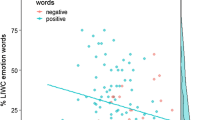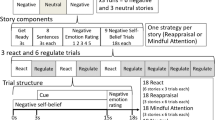Abstract
Thirty-two female subjects cognitively rehearsed previously rated, important self-referent statements while psychophysiological measures of arousal (heart rate, skin conductance, and finger pulse volume)were recorded. The self-statements, based on academic, social, and family-parental problem areas, were either positively or negatively valenced. Additionally, the self-statements varied on the degree of discrepancy (distance from the the subject's belief about herself)and were presented along with neutral statements. No difference between the valenced self-statements and the neutral statements was shown by any physiological measure. For skin conductance, a significant valence by discrepancy interaction indicated that the negative, moderately discrepant statements induced greater arousal than the positive, moderately discrepant self-statements. The skin conductance results are interpreted via cognitive-behavioral and social judgment theory, and the therapeutic implications are discussed.
Similar content being viewed by others
Reference Notes
Craighead, W. E., Rogers, T., & Bauer, R. M.Cognitive mediation of physiological arousal: A methodological review. Unpublished manuscript, Pennsylvania State University, 1977.
Craighead, W. E., & Craighead, L. A.Some implications of attitude-change research for the modification of self-statements. Unpublished manuscript, Pennsylvania State University, 1977.
References
Aderman, D. Relation, depression, and helping behaviors.Journal of Personality and Social Behaviors 1972,24 91–101.
Alnutt, R. W., Becker, W. D., & Barbiere, R. E.Techniques of physiological monitoring (AMRL-TDF-62-98 III). Aerospace Medical Research Laboratories, Aerospace Medical Division, Air Force Systems Command, Wright-Patterson AFB, Ohio, October 1964. (NTIS No. AD-609 481)
Beck, A. T.Cognitive therapy and the emotional disorders. New York: International Universities Press, 1976.
Coleman, R. E. Manipulation of self-esteem as a determinant of mood of elated and depressed women.Journal of Abnormal Psychology 1975,84 693–700.
Craighead, W. E., Kazdin, A. E., & Mahoney, M. J.Behavior modification: Principles, issues, and applications. Boston: Houghton Mifflin, 1976.
Ellis, A.Reason and emotion in psychotherapy. New York: Lyle Stuart, 1962.
Ellis, A.The essence of rational psychotherapy: A comprehensive approach to treatment. New York: Institute for Rational Living, 1970.
Fishbein, M., & Ajzen, I.Belief, attitude, intention, and behavior: An introduction to theory and research. Reading, Massachusetts: Addison-Wesley, 1975.
Freedman, J. L. Involvement, discrepancy, and change.Journal of Abnormal and Social Psychology 1964,69 290–295.
Goldfried, M. R., Decenteceo, E. T., & Weinberg, L. Systematic rational restructuring as a self-control technique.Behavior Therapy 1974,5 247–254.
Goldfried, M. R., & Goldfried, A. P. Cognitive change methods. In F. H. Kanfer & A. P. Goldstein (Eds.),Helping people change. New York: Pergamon, 1975.
Goldfried, M. R., & Sobocinski, D. Effects of irrational beliefs on emotional arousal.Journal of Consulting and Clinical Psychology 1975,43 504–510.
Hale, W. D., & Strickland, B. R. The induction of mood states and their effect on cognitive and social behaviors.Journal of Consulting and Clinical Psychology 1975,44 155.
Hovland, C. I., Harvey, O. J., & Sherif, M. Assimilation and contrast effects in reactions to communication and attitude change.Journal of Abnormal and Social Psychology 1957,34 257–261.
Lacey, J. I. The evaluation of autonomic responses: Toward a general solution.Annals of the New York Academy of Sciences 1956,67 123–164.
Lader, M. Psychophysiological parameters and methods. In L. Levi (Ed.),Emotions: Their parameters and methods. New York: Raven, 1975.
Levenson, R. W. Feedback effects and respiratory involvement in voluntary control of heart rate.Psychophysiology 1976,13 108–114.
Mahoney, M. J.Cognition and behavior modification. Boston: Ballinger, 1974.
Mahoney, M. J., & Arnkoff, D. Cognitive and self-control therapies. In S. L. Garfield & A. E. Bergin (Eds.),Handbook of psychotherapy and behavior change (2nd ed.). New York: Wiley, 1977.
May, J. R., & Johnson, H. J. Physiological activity to internally elicited arousal and inhibitory thoughts.Journal of Abnormal Psychology 1973,82 239–245.
Meichenbaum, D.Cognitive behavior modification. Morristown, New Jersey: General Learning Press, 1974.
Meichenbaum, D.Cognitive-behavior modification. New York: Plenum, 1977.
Meyers, A. W., & Craighead, W. E. Adaptation periods in clinical psychophysiology.Behavior Therapy, in press.
Orne, M. T. On the social psychology of the psychological experiment: With particular reference to demand characteristics and their implications.American Psychologist 1962,17 776–783.
Rimm, D. C., & Litvak, S. B. Self-verbalization and emotional arousal.Journal of Abnormal Psychology 1969,74 181–187.
Russell, P. L., & Brandsma, J. M. A theoretical and empirical investigation of the rationalemotive and classical conditioning theories.Journal of Consulting and Clinical Psychology 1974,42 389–397.
Sherif, C. W.Orientation in social psychology. New York: Harper & Row, 1976.
Sherif, M., & Hovland, C. I.Social judgment: Assimilation and contrast effects in communication and attitude change. New Haven: Yale University Press, 1961.
Stern, R. M., & Anschel, C. Deep inspirations as stimuli for response of the autonomic nervous system.Psychophysiology 1968,5 132–141.
Sternbach, R. A.Principles of psychophysiology: An introductory text and readings. New York: Academic Press, 1966.
Strickland, B. R., & Hale, W. D. Effect of induced mood states on activity and self-reported affect.Journal of Consulting and Clinical Psychology 1975,43 587.
Thorne, P. R., Engel, B. T., & Holmblad, J. B. An analysis of the error inherent in estimating heart rate from cardiotachometer records.Psychophysiology 1976,13 269–272.
Velten, E. A laboratory task for induction of mood states.Behaviour Research and Therapy 1968,6 473–482.
Wilcoxon, L. A.Therapeutic effects of self-instructional training for nonassertive women. Unpublished doctoral dissertation, Pennsylvania State University, 1976.
Wilder, J. The law of initial values in neurology and psychiatry: Facts and problems.Journal of Nervous Mental Disorders 1957,125 73–86.
Zuckerman, M., & Lubin, B.Manual for the multiple affect adjective check list. San Diego: Educational and Industrial Testing Service, 1965.
Author information
Authors and Affiliations
Additional information
This research was supported in part by a grant from Pennsylvania State University, College of Liberal Arts, Central Fund for Research. Appreciation is expressed to Lorraine DePaul, Diane Zacher, John Trach, Bill Hickey, and Elizabeth Rice for their assistance in the completion of this study.
Rights and permissions
About this article
Cite this article
Rogers, T., Craighead, W.E. Physiological responses to self-statements: The effects of statement valence and discrepancy. Cogn Ther Res 1, 99–119 (1977). https://doi.org/10.1007/BF01173632
Issue Date:
DOI: https://doi.org/10.1007/BF01173632




